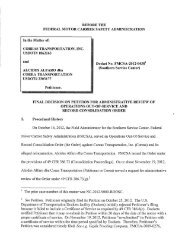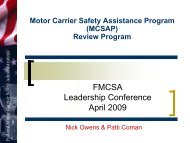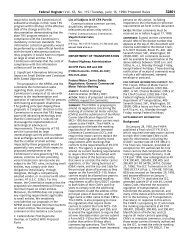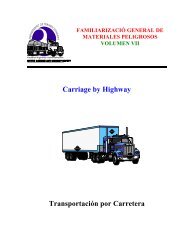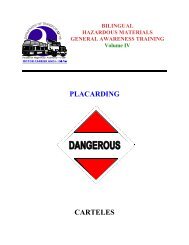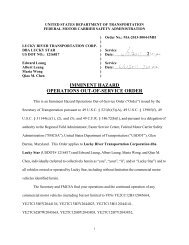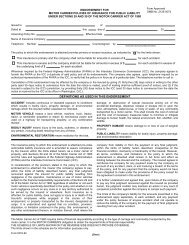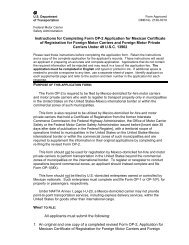office of analysis, research, and technology - Federal Motor Carrier ...
office of analysis, research, and technology - Federal Motor Carrier ...
office of analysis, research, and technology - Federal Motor Carrier ...
You also want an ePaper? Increase the reach of your titles
YUMPU automatically turns print PDFs into web optimized ePapers that Google loves.
IntelliDrive Safety Applications for Commercial Vehicles January 20, 2010<br />
compelling stories to tell; much better examples <strong>of</strong> how vehicle-to-vehicle safety within the truck<br />
realm is being delivered.<br />
Thanks, Jon.<br />
SLIDE 30: AGENDA<br />
Jon Mueller (General Engineer, FMCSA ART):<br />
Thank you, Tom—appreciate it. Next on the agenda, we will hear about an example <strong>of</strong><br />
commercial vehicle IntelliDrive that is actually in place <strong>and</strong> working. Rick McDonough is with<br />
the New York State DOT’s Office <strong>of</strong> Modal Safety <strong>and</strong> Security. He is the Program Manager <strong>of</strong><br />
the Commercial Vehicle Infrastructure Integration Project <strong>and</strong> is going to highlight the activity<br />
<strong>of</strong> that effort. Rick, go ahead.<br />
PAUSE<br />
SLIDE 31: COMMERCIAL VEHICLE INFRASTRUCTURE INTEGRATION A.K.A. COMMERCIAL<br />
VEHICLE INTELLIDRIVE<br />
Rick McDonough (Program Manager, NYSDOT):<br />
I am Rick McDonough. As Jon mentioned, I am the Program Manager for the CVII Project, also<br />
called Commercial Vehicle or Heavy Vehicle IntelliDrive. This has been a program that has<br />
been—we have been working on from concept to initiation probably for about 2½ –3 years.<br />
SLIDE 32: COMMERCIAL VEHICLE INFRASTRUCTURE INTEGRATION (CVII) PROGRAM<br />
Once we looked at the initial Vehicle Infrastructure Integration program, which was the previous<br />
name <strong>of</strong> the IntelliDrive program, we looked at it, <strong>and</strong> noticed that one component that was not<br />
being addressed was heavy vehicles—commercial vehicles. With cooperation, partnership, <strong>and</strong><br />
support from the I-95 Corridor Coalition, we received funding to start addressing that aspect <strong>of</strong><br />
5.9 GHz <strong>technology</strong>. We had a couple <strong>of</strong> goals—one <strong>of</strong> goals was to make sure that this led to a<br />
completely interoperable system. That is really the beauty <strong>of</strong> the IntelliDrive or the 5.9<br />
<strong>technology</strong> arena, is that it really addresses some <strong>of</strong> the problems we have seen in the past with<br />
other types <strong>of</strong> <strong>technology</strong>, particularly in the ITS field. And a perfect example <strong>of</strong> that is<br />
transponder <strong>technology</strong>, where you need different transponders, even though they are all<br />
operating at 915 MHz frequency, to do border crossings, or to do tolling, or to do screening for<br />
commercial vehicles either at weigh stations or electronic screening systems. That is really one<br />
<strong>of</strong> the benefits <strong>of</strong> this <strong>technology</strong>. Also, we wanted this <strong>technology</strong> to integrate with the databus<br />
<strong>of</strong> a commercial vehicle—<strong>and</strong> that is really the “brains” <strong>of</strong> the vehicle systems. Fortunately, the<br />
heavy vehicle industry is much more advanced <strong>and</strong> more st<strong>and</strong>ardized in those systems, so it is a<br />
little easier to deal with it across manufacturers <strong>and</strong> across the industry.<br />
11



